Mary Anne Yarde's Blog: The Coffee Pot Book Club , page 155
February 1, 2019
#BookReview — The Labyrinthine Journey (Servant of the Gods Book 2), by Luciana Cavallaro #HistoricalFantasy #AncientGreece @ClucianaLuciana
 The Labyrinthine Journey(Servant of the Gods Book 2)By Luciana Cavallaro
The Labyrinthine Journey(Servant of the Gods Book 2)By Luciana Cavallaro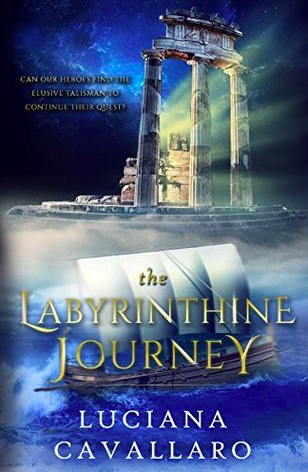
Follow Evan as he continues his odyssey as Servant of the Gods in The Labyrinthine Journey. The quest to locate the sacred object adds pressure to the uneasy alliance between Evan and the Atlanteans. His inability to accept the world he’s in, and his constant battle with Zeus, both threaten to derail the expedition and his life.
Traversing the mountainous terrain of the Peloponnese and Corinthian Gulf to the centre of the spiritual world, Evan meets with Pythia, Oracle of Delphi. Her cryptic prophecy reveals much more than he expected; something that changes his concept of the ancient world and his former way of life.
Will Evan and his friends succeed in their quest to find the relics and stop the advent of Christianity?

"The time to restore the true path has come, and my bloodline will become king of the human race."
It is prophesied that the Gods of Olympus will be eclipsed by a man whom the people will call the Messiah. That cannot be allowed to happen.
Evan has been summoned by his father, Zeus, the King of the Gods, to partake in a very time sensitive quest. If he fails, then nothing will ever be the same again. Evan, along with some new friends from Atlanta set out on an epic journey to find the ancient relics which will save the Gods from an eternity of obscurity. However, it will be no easy task for there is one who is determined to see the Gods fall and the Messiah rise.
The Labyrinthine Journey (Servant of the Gods Book 2) by Luciana Cavallaro is no ordinary time-travel story. Prepare to meet deities, heroes and a whole host of mythological creatures.
Cavallaro has drawn from her extensive knowledge of Greek mythology and has written a story that will not only hook her readers but hold them captivated until the very last sentence. The narrative is refreshingly rich and vibrant. The story itself is bold and successful.
Throwing aside the boundaries of time and place, Cavallaro has carefully brought together some of the great names in Greek philosophy as well as some of the most memorable Greek heroes and Gods from that time. So be ready to meet, Zeus, Poseidon, Hera, Ares, Kronos, Plato, Jason and his famous Argonauts as well as a host of other fabulous characters. Bringing these characters together works very well for Cavallaro’s purpose of presenting a very entertaining and riveting tale.
I thought Evan made a superb protagonist. He is a foreigner in this classical civilisation, having been brought from his comfortable life in the 21st Century by Zeus. Evan draws upon his knowledge of both the birth of Jesus and the contemporary interpretation of this ancient world he now finds himself in. Every so often he lets slip a modern term, only to be met with blank faces — some of his explanations were fabulous, and I must admit, I don’t think I would have explained how an aeroplane stays in the air quite as well!
Evan is a very driven character who simply wants to get on with the quest so he can go back to the time and life he knows. Unlike others, Evan does not cower when the Gods present themselves. He stands his ground. Evan does not fear them, for he knows their secrets, and he does not respect them as a hero usually does, which makes this story a little different from other Greek mythology tales that are out there. At times he can be somewhat temperamental, but then so would anyone who had found themselves stolen from their own time and thrown into a world of Gods, monsters and, if I may play on words a little, χάος — chaos!
Cavallaro has skillfully included a shadowy counterplot to this story, and by doing so, we have been given the privilege of following the antagonist’s tale as well. I was really surprised how well this worked. Usually I like my protagonists to be somewhat blind to the danger they are in, but in this case, I found myself enthralled by the antagonist's attempts to thwart the heroes. Kudos, Ms Cavallaro for thinking outside of the box.
The Labyrinthine Journey is the 2nd book in the Servant of the Gods series — I have not had the pleasure of reading book 1, but this did not impede my enjoyment of this story at all. The Labyrinthine Journey stands very firmly on its own feet.
What else can I say about this remarkable book but, be prepared to expect the unexpected! The storyline was refreshingly original, and there are certainly enough plot twists to keep the reader engaged. This is one adventure you don’t want to miss. Great for fans who have grown up with Rick Riordan’s fabulous Percy Jackson and Heroes of Olympus series!
I Highly Recommend.
Review by Mary Anne Yarde.The Coffee Pot Book Club.
Amazon UK • Amazon US
Luciana Cavallaro
 Historical fiction novelist and a secondary teacher, Luciana Cavallaro, likes to meander between contemporary life to the realms of mythology and history. Luciana has always been interested in Mythology and Ancient History but her passion wasn't realised until seeing the Colosseum and the Roman Forum. From then on, she was inspired to write Historical Fantasy.
Historical fiction novelist and a secondary teacher, Luciana Cavallaro, likes to meander between contemporary life to the realms of mythology and history. Luciana has always been interested in Mythology and Ancient History but her passion wasn't realised until seeing the Colosseum and the Roman Forum. From then on, she was inspired to write Historical Fantasy.Connect with Luciana: Website • Twitter
Published on February 01, 2019 23:30
#BookReview — Victus: The Civilis Saga #1 by Peter Baggott #Historical Fiction #AncientRome @baggott_scot

VictusThe Civilis Saga #1 By Peter Baggott
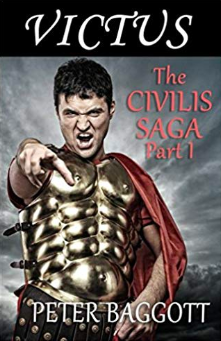 ROME 31AD
ROME 31ADVictus Antonius Claudian, sadist and rake seeks fame and fortune from his new mentor the Praetorian Commander and Ruler of Rome, Sejanus. With his only sister Porcia, he plans to elevate himself in Rome’s society through a well-placed marriage.
The Civilis menfolk consist of a Senator, Lictus, his only son Artorius, Primus Pila of the 1st Century 1st Cohort of the 2nd Augusta Legion, and two grandsons Cassius and Marcus.
Fate or fortune brings Cassius and Porcia together with an inevitable consequence. On the same day as Victus is sent north by his mentor Sejanus to raise support amongst the Northern Legions for his cause, to become Caesar, he finds his sister is pregnant. In his search for the father of his sister’s child he takes revenge on him and is protected by his mentor.
The Civilis’ turn to Tiberius for justice, as does the senate against Sejanus’ rule. Sejanus is denounced by Tiberius, who demands that the Senate sentence Sejanus.
Victus’ world implodes. He has his fortune, but now he is a hunted man and the only way back out of his exile is to remove the Civilis family and friends.

Commanding, compulsive and utterly captivating.
Lucius Aelius Sejanus — commander of the Praetorian Guard and confidant of Emperor Tiberius — needs a new Camp Prefect of the Guard. Sejanus is looking for a man who is ruthless and a stickler for discipline. He also needs this man to act as his senior speculator.
Sejanus is secure in his position of power. There is only one other in the Empire that is more powerful than he is and that is the Emperor himself. Ambition drives Sejanus, and now he wants what Tiberius has.
Victus Antonius Claudian could very well be the man that Sejanus has been looking for. Victus’ reputation proceeds him. He is a ruthless, and cruel man. He is also very ambitious, much like his sponsor. With his new position as Camp Prefect of the Guard, he is determined to see his family rise to greatness. His younger sister, Porcia, could help him achieve such greatness. All he has to do is marry her to a wealthy, influential Roman.
Unlike her brother, Porcia is a gentle soul who has fallen in love with Senator Lictus’ grandson. Unfortunately, such a romance is doomed from the beginning, but Porcia does not care for she is devoted to Cassius and she is expecting his baby.
With his new position, Victus feels invincible. No one can touch him. No one can stop him. Nothing, not even his sister, will get in his way. Power and wealth are his for the taking.
From a forest clearing in the south of Mogontiacum in Germania to the Temple of Concord in the ancient city of Rome, Victus: The Civilis Saga #1 by Peter Baggott is an example of historical fiction at its very best.
Baggott has tread with scrupulous care when portraying the history of this time. Baggott does not present us with a Hollywood gilded Rome, but instead, he offers his interpretation of a very real one. Baggott has a great novelist eye for human fragility, and nothing is beyond his telling. Reading this book was like going back in time with a very competent tour guide. The streets of Rome came alive under Baggott’s masterful scholarship. One could almost smell the stench coming off the River Tiber, as well as the more appetising smell of freshly baked pies sold in the market. Nothing is left to the imagination either, Baggott takes us to brothels, barracks, and the steep steps of the Temple of Concord. We run alongside street urchins, thugs, soldiers, spies, and of course, the endearing Civilis’ family. When historical fiction is written in this way, there is no such thing as too much! This is a story that threatens to mesmerise.
There are some very memorable characters in this book, and all have their own stories to tell. I was fascinated by Corvus, who lost his sight while in the service of Rome. He may be blind, but he sees more than most.
In particular, I enjoyed reading about Marcus, the youngest grandson of Senator Lictus. His journey to manhood is an interesting one. His relationship with Tia was beautiful to behold. Theirs is also a forbidden love, but Marcus is determined to keep Tia safe at all costs. I could not help but like Marcus. He is such a wonderfully compassionate young man.
Another character worthy of mention is Artorius Primus Pila, Senator Lictus’ son and Marcus’ father. Artorius’ story really comes into its own in the latter half of this book. Like his father and son, Artorius was a character I adored. He is honourable, brave and above all fiercely loyal to his Emperor and to his family.
Baggott’s portrayal of his antagonist was masterfully done. Victus is a powerfully sadistic character which drove this story forward. What makes Victus so interesting is that he is very intelligent, and his actions, for the most part, are coldly calculated, which make for a very chilling read.
The narrative is incredibly fast-paced with non-stop action. One thing is for sure, Baggott’s writing can never be accused of being dull! The historical backdrop has been painstakingly researched, and the story was absolutely riveting. Victus: The Civilis Saga #1 is not only a very bold book, but it is also immensely successful — it is entertaining, gripping, and very hard to put down. If you are looking for a great adventure with unforgettable characters, then look no further, this is the book for you.
I Highly Recommend.
Review by Mary Anne Yarde.The Coffee Pot Book Club.
Amazon UK • Amazon US
Peter Baggott
 Peter Baggott is a debut author with a deep interest in Roman history. He has served in three uniformed employments and is very familiar with Roman tactics which are still used in everyday life: shield tactics and skills – testudo being much used in the Police and Prison Service.
Peter Baggott is a debut author with a deep interest in Roman history. He has served in three uniformed employments and is very familiar with Roman tactics which are still used in everyday life: shield tactics and skills – testudo being much used in the Police and Prison Service.Peter chose for his writing this historical genre because of his innate interest in the subject and having been born in the Roman city of Lindvm, modern day Lincoln.
In his teens, on a daily basis, while delivering newspapers, Peter traversed the exposed Roman remains from The Steep to the Newport Arch, the only full Roman archway in Great Britain.
While working in a local hotel close to the ruins he utilised this knowledge to become a self-appointed guide to visitors from far and wide and has continued to keep up to date with local finds. There are many stories surrounding the infamous Legio IX Hispana, who were based in Lindvm, their disappearance has inspired his continuing interest in all things Roman.
Peter has also visited numerous Roman sites, both in the UK and in Europe and has used original Roman historical sources of Tacitus, Suetonius and Dio, Google Maps for distancing and location, Wikipedia and several archaeological online sources. Thus, he tries to keep abreast with new finds upgrading his work accordingly.
Connect with Peter: Website • Twitter
Published on February 01, 2019 23:00
Samantha Wilcoxson's fabulous book, Plantagenet Princess, Tudor Queen, is now available on #NetGalley #Booksgosocial #HistoricalFiction @carpe_librum @LPOBryan
Have you heard…?
Samantha Wilcoxson's fabulous book, Plantagenet Princess, Tudor Queen, is available on NetGalley for your reading pleasure. If you love great historical fiction then this is the book for you.

Plantagenet Princess, Tudor Queen
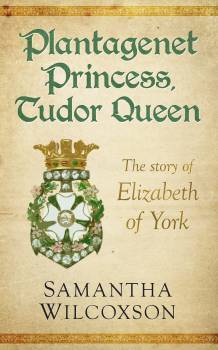
She was the mother of Henry VIII and wife of Henry VII, but who was Elizabeth of York? Raised as the precious eldest child of Edward IV, Elizabeth had every reason to expect a bright future until Edward died, and her life fell apart.
When Elizabeth's uncle became Richard III, she was forced to choose sides. Should she trust her father's brother and most loyal supporter or honor the betrothal that her mother has made for her to her family's enemy, Henry Tudor?
The choice was made for her on the field at Bosworth, and Elizabeth the Plantagenet princess became the first Tudor queen.Did Elizabeth find happiness with Henry? And did she ever discover the truth about her missing brothers, who became better known as the Princes in the Tower?
Lose yourself in Elizabeth's world in Plantagenet Princess Tudor Queen.This novel has been selected by the Historical Novel Society as an Editors' Choice and long-listed for the 2016 HNS Indie Award.To grab your copy of Plantagenet Princess, Tudor QueenClick
HERE!
What is NetGalley?
How It Works (in their own words…)NetGalley connects publishers and authors to an enthusiastic community of early influencers who will help their book succeed: librarians and booksellers who order and recommend books to their patrons, media professionals who interview authors, reviewers and bloggers who write about books online and leave reviews on retail sites, and more. Publishers and authors list their titles on NetGalley for members to request, read, and review, and members gain free access to a vast catalog of digital review copies.
NETGALLEY FOR MEMBERS
NetGalley is a service to help readers of influence discover and recommend new books to their audiences. If you are a reviewer, blogger, librarian, bookseller, educator, journalist or other member of the media, you can use NetGalley for free to request, read, and recommend books before they are published.Your reviews and feedback are essential to publishers and other readers!
Become a NetGalley member today! NetGalley
NetGalley for Authors
Are you an author? Would you like to see your book on NetGalley. The Coffee Pot Book Club offers affordable NetGalley promotion. Click HERE to find out more.
Samantha Wilcoxson's fabulous book, Plantagenet Princess, Tudor Queen, is available on NetGalley for your reading pleasure. If you love great historical fiction then this is the book for you.

Plantagenet Princess, Tudor Queen

She was the mother of Henry VIII and wife of Henry VII, but who was Elizabeth of York? Raised as the precious eldest child of Edward IV, Elizabeth had every reason to expect a bright future until Edward died, and her life fell apart.
When Elizabeth's uncle became Richard III, she was forced to choose sides. Should she trust her father's brother and most loyal supporter or honor the betrothal that her mother has made for her to her family's enemy, Henry Tudor?
The choice was made for her on the field at Bosworth, and Elizabeth the Plantagenet princess became the first Tudor queen.Did Elizabeth find happiness with Henry? And did she ever discover the truth about her missing brothers, who became better known as the Princes in the Tower?
Lose yourself in Elizabeth's world in Plantagenet Princess Tudor Queen.This novel has been selected by the Historical Novel Society as an Editors' Choice and long-listed for the 2016 HNS Indie Award.To grab your copy of Plantagenet Princess, Tudor QueenClick
HERE!
What is NetGalley?
How It Works (in their own words…)NetGalley connects publishers and authors to an enthusiastic community of early influencers who will help their book succeed: librarians and booksellers who order and recommend books to their patrons, media professionals who interview authors, reviewers and bloggers who write about books online and leave reviews on retail sites, and more. Publishers and authors list their titles on NetGalley for members to request, read, and review, and members gain free access to a vast catalog of digital review copies.
NETGALLEY FOR MEMBERS
NetGalley is a service to help readers of influence discover and recommend new books to their audiences. If you are a reviewer, blogger, librarian, bookseller, educator, journalist or other member of the media, you can use NetGalley for free to request, read, and recommend books before they are published.Your reviews and feedback are essential to publishers and other readers!
Become a NetGalley member today! NetGalley
NetGalley for Authors
Are you an author? Would you like to see your book on NetGalley. The Coffee Pot Book Club offers affordable NetGalley promotion. Click HERE to find out more.
Published on February 01, 2019 00:43
January 31, 2019
A conversation with Historical Romance author, Ruth Kaufman. #HistoricalRomance #WarOfTheRoses @RuthKaufman
A conversation with Historical Romance author, Ruth Kaufman.

I am so excited, Ruth Kaufman is on the blog today. Let's give her a warm Coffee Pot welcome.
Hi Ruth, for my readers who may not be familiar with your work, could you share a little about yourself?
Absolutely! I’m Ruth Kaufman, author of six novels and a novella, and one audiobook (I voiced the female characters). I’m also an actor, primarily on-camera and voiceovers.
An author and an actor — how fabulous! I was wondering if you could tells us about the inspiration behind your wonderful trilogy — The Wars of the Roses Brides?
I’d been reading historical romance for years, and pondered writing my own. One day, the first scene for the first book popped into my head, and I was off! After I finished the first book, I decided to try something a little different when creating a series…the trilogy is connected by the underlying history, which I think shows how the times my characters lived in affected choices, decisions and actions. Each book also stands alone.
The Wars of the Roses Brides sounds amazing. Did you find it a challenge to research this period in history?
Finding the level of detail I wanted was a challenge. You can’t just say, for example, “They ate a meal.” You want to share what they ate, or wore. To incorporate as much historical accuracy as possible, I reviewed many sources. For years I’d been collecting books on 15th Century England, which helped, but I also spent a lot of time at Chicago’s Newberry Library, and for my second book was able to look at a hard-to-find book at The Art Institute.
There are many books about late medieval England. Can you tell us three things that set your trilogy apart?
1) Actually, I haven’t found as many during the reign of Henry VI or even Edward IV as I’ve seen in other time periods. I don’t know of any dealing with Henry VI’s illness and how that impacted the country and its people, which is what my first book is about.
2) I’d like to think the way I incorporate actual historical detail and events into the story is somewhat different. I like to have my characters take part in actual events. In my first book, the hero is in a battle. Fortunately, I found a couple of good, detailed descriptions of what happened that day. And I actually visited Castle Rising, where the heroine lives…and the designer was able to use it on the cover.
 Castle Rising
Castle Rising3) I think my heroines do unusual things for their time. One is a scribe for the queen (and also the king’s rival for the throne), one is a glazenwright (stained-glass designer) and the third plans a bride tournament.
Castle Rising is very beautiful. Your trilogy sounds amazing. I love the fact that one of your heroines is a glazenwright! So what is next on your agenda?
I’m finishing my second novella for WolfeBane Publishing, My Rebel, My Love, set in 13th Century England.
That sounds amazing as well. Thank you for coming onto the blog today, would you mind telling us a little more about your fabulous trilogy — The Wars of the Roses Brides?
Of course. This trilogy contains three acclaimed full-length medievals set in England during what we now call the Wars of the Roses:
At His Command
 1453
1453Can she defy her king for love?
What’s a lady to do when the king commands her to wed How can she follow the king's command when she's a scribe for his rival? How can she marry another man when she's falling in love with Nicholas?
Amazon
Follow Your Heart
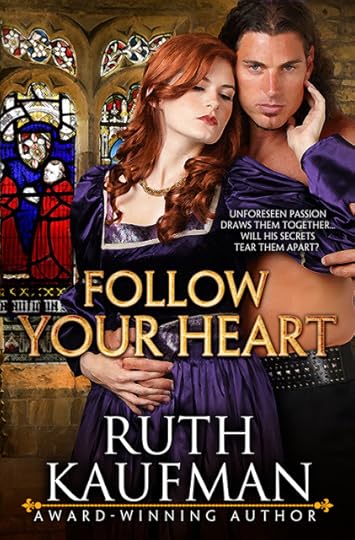
1460
A glazenwright needs help to save her glass-painting studio from ruin. A knight trying to regain his family’s estates needs an heir. When irresistible attraction makes their marriage of convenience inconvenient, will his dangerous secrets keep them from following their hearts?
Amazon
The Bride Tournament
1462
So she doesn’t have to marry the new earl, Lady Eleanor de la Tour holds a bride tournament to find him a better bride. Who will win his hand in marriage...and his love?
Amazon
Or Read for FREE with

At His Command — Excerpt & Giveaway
Sir Nicholas Grey’s scout leaned forward in his saddle, holding up two fingers to let the others know two horses approached. Nicholas heard only the slight jangling of harnesses blended with wind rattling through the trees, but relied on his scout’s uncanny ability to hear what no one else could.
He and his eight men sat alert, deep enough in the forest to avoid being seen while maintaining a clear view of the road through leafless branches. Nine armed men could frighten travelers. ‘Twas best to let them pass.
Each man watched, each horse sinking deeper into chilling mire as a mud-covered, black palfrey plodded over the rise in the road, its long mane whipping in the frigid winds.
“No rider,” Martin, the scout, murmured.
“Look again,” Nicholas replied. At first he too had thought the horse was riderless. Now he could see a woman collapsed on the animal’s back. Her dark hair draped down its flank, mingling with the horse’s mane. The palfrey placed each step as if trying not to jostle its burden.
Another horse, this one a brown rouncey ridden by a thin, balding man, galloped after the palfrey. A look of triumph brightened the man’s face as he spotted the horse ahead of him. He bent forward, extending his hand. Fingers like talons grasped the woman’s tangled hair.
“Mine!” he cried.
* * *
Amice Winfield jerked awake. Agony forced her head back, allowing her to see the man who gripped her hair as though he’d perish if he let go.
Harry Winfield.
She screamed. Arrows of fear pierced her as she clawed at his fingers. Her horse bolted, leaving her dangling from Harry’s hand by a small clump of hair. The long strands held for a few seconds, then tore from her head.
Pain seared her scalp. She dropped into a puddle. Stunned by her fall and her stinging head, Amice could only stare at her tormentor while freezing water soaked her clothes. How she hated him. How she regretted her desperate flight from home. But what other choice did she have?
Harry gaped at the dark tresses hanging from his hand. He threw them to the ground as she struggled to rise. Panic gripped her as his hostile glare changed to a slow, confident smile.
“There’s nowhere to run. I’ll catch you if it’s the last thing I do,” he vowed. He leapt off his horse.
Amice tugged her sodden skirts, trying to haul them out of the puddle. Where was her mount? Too far away to reach without being caught, weighted down as she was. Sprays of water flew as she heaved her skirts over her arm. Heart racing, she ran for the trees. A branch snagged her. With a cry of frustration, she pulled the wet wool until it wrenched free.
Ignoring twigs tearing at her skin and icy mud that sucked away one of her shoes, she forged ahead. She gasped for air as she plunged into a tiny clearing, then came to an abrupt halt at the sight of a group of mounted men. Slimy hair slapped her face and clung to her cheek.
Panting, cold air stinging her throat, she sought a path to escape the strangers. Alarm coursed through her. She focused on the man at the head of the group. Anxiety and uncertainty warred within her though she sensed an almost tangible power emanating from him. The wind tossed his chin-length black hair as he stared down with a stern expression.
Will he help me? Am I better off with him or...? Before Amice could decide, branches snapped behind her. Harry ran into the clearing.
Giveaway
Ruth Kaufman is giving away two ebook copies of her fabulous book “At His Command.”

To be in with a chance just answer this question...
What do you like about historical romance?
Giveaway Rules
• Leave your answer in the comments at the bottom of this post.• Giveaway ends at 11:59pm GMT on February 27th.• You must be 18 or older to enter. • Giveaway is open INTERNATIONALLY.•Only one entry per household. • All giveaway entrants agree to be honest and not cheat the systems; any suspect of fraud is decided upon by blog/site owner and the sponsor, and entrants may be disqualified at our discretion.•Winners will be announced in the comments.
Ruth Kaufman

Ruth Kaufman’s Wars of the Roses Brides trilogy (AT HIS COMMAND, FOLLOW YOUR HEART and THE BRIDE TOURNAMENT) reached #1 historical romance on Amazon in the US, Canada and Australia. Her romantic comedy MY LIFE AS A STAR is the standalone prequel to MY LIFE AS AN EXTRA. Accolades include 2016 Booksellers' Best Award double winner (Best Historical and Best First Book) and Romance Writers of America® Golden Heart® winner.
Ruth is also an on-camera and voiceover talent with a J.D. and a Master's in Radio/TV. Credits include independent feature films, short films, web series, national TV commercials and thousands of voiceovers. She presents workshops for authors and actors and is a comedic storyteller.
Connect with Ruth: Website • Facebook • Facebook: Ruth Kaufman Actor & Author • Twitter • Instagram • Amazon Author Page.
Published on January 31, 2019 23:00
January 30, 2019
Women as Chattel, by Glynnis Campbell #History #MiddleAges @GlynnisCampbell
Women as Chattel By Glynnis Campbell
Chattel. It means a movable article of property.
Most of us have heard that women of the Middle Ages were considered chattel. They had no rights of their own, but were merely the property of the man who owned them. As such, they could be sold, traded, or married off against their will.

It may not surprise you to learn that the term "chattel" comes from the medieval word for "cattle." That's right—women had about as much standing in society as COWS.
And from some of the things we've all read, it's easy to believe this was true.
I'm here to tell you that's not entirely accurate.
While medieval women may not have enjoyed equality in all things, they had far more power and responsibility than we've been led to believe.
So why does this medieval "women as chattel" myth persist?
I blame priests.
In the Middle Ages, priests made up the largest sector of the literate population. Therefore, they did the bulk of the reading and writing of the time. And they recorded the world the way they saw it.
Think about that.
Here was a group that was exclusively men. Many of them were well-educated nobles that had been forced into their profession, not by choice, but because they were a spare heir—a second or third son who had to choose between living in the church and possibly dying in the king's army.
They wore scratchy cassocks. They shaved their heads. They slept on straw and woke up at all hours to pray. Some of them took vows of silence. But above all, they were required to be celibate.

Is it any wonder they were a little bitter toward women?
To add to the misogyny, priests were taught that women had descended from that weak-willed temptress Eve, who had disobeyed God and screwed up the earthly Paradise of Eden for EVERYONE.
In light of her obvious lack of judgment and morality, not to mention her wily ways, how could a woman ever be trusted with important decisions? It was only natural then that a man should make all the decisions for her. She should wed the man chosen for her, give him babies, and be subservient to him in every way.
Take THAT, Eve!
However…
If you dig deeper—beyond the records of cranky priests—if you peruse business ledgers, official government documents, and personal letters, you find an entirely different portrait of medieval women.
Here are some interesting surprises:
♥ In feudal times, every lord owed his king 40 days per year of military service. For those several weeks that the lord was at war and away from home, his capable wife was usually left in charge of the household and castle defenses.

♥ When a professional member of a guild—such as a silversmith, a weaver, or a woodcarver—passed away, the guildsman's trade was often taken over by his wife. This included not only the craft work, but also running the business and keeping the accounts.
♥ Unmarried women who owned property through inheritance or widowhood were afforded the same rights and respect as their male counterparts with regards to the law.
♥ One of the most beloved and popular authors of love stories in the Middle Ages was a woman, Christine de Pizan. Not only was she a prolific romance novelist, but she was a women's rights activist who defended a more enlightened role for women in society in her utopian fiction, "The Book of the City of Ladies."

♥ Medieval women sometimes donned armor and marched into battle. We know about Joan of Arc, but have you heard of Isabel of Conches, who rode with her husband's knights? What about "Fiery" Joanna of Flanders, who led her townspeople in fending off 300 attackers with stones? Or Matilda of Canossa, who had a 30-year military career? Even Christopher Columbus's patron, Queen Isabella, took to the field in full armor to command her troops.
These women were clearly no spun-sugar damsels in distress. And this vision of empowered heroines is far more real and appealing to me.
That's why my novels feature plucky, in-your-face (and sometimes kick-your-arse) heroines. I prefer to write about hard-working, goal-driven, salt-of-the-earth women—women with a sense of humor who aren’t afraid to get their hands dirty and their hackles up...
In MY CHAMPION, a pint-sized merchant dares to face down pirates.
In LADY DANGER, a Scots maid in armor defends her clan with a blade.

In MacADAM'S LASS, a tavern wench spies for Mary Queen of Scots.
In MEDIEVAL OUTLAWS, a thieving urchin stands up to the local lawman, a runaway bride bargains with a dangerous outlaw, and a female Robin Hood holds a knight for ransom.

And in my upcoming release, BRIDE OF FIRE, Book 1 of The Warrior Daughters of Rivenloch, a bold Scots lass challenges a Highlander for his claim to her castle.
I love dreaming up female characters with adventure in their blood and take-no-prisoner attitudes. But it's even more exciting to create heroes strong enough to stand up to my heroines’ spirited ways, yet worthy enough to win their wild hearts.
If you'd like to get up to speed with The Warrior Maids of Rivenloch before their daughters embark on new romantic adventures in BRIDE OF FIRE, here's the discounted boxed set!
Maids with Blades

Damsels in shining armor...riding to the rescue!
Deirdre, Helena, and Miriel, three kick-arse Scots wenches known as The Warrior Maids of Rivenloch, aren’t about to become any man’s chattel, until they meet heroes who are strong enough to tame their wild ways and worthy enough to win their wayward hearts.
Book 1: Lady Danger
A beautiful female warrior has never had trouble turning away men, but when she marries a powerful lord to save her sister, she soon finds herself losing the battle over her heart.
Book 2: Captive Heart
A fierce warrior maid tries to save her sister from marriage by abducting the groom's right-hand man, a plan that goes awry when her hostage is all-too-willing to succumb to her demands.
Book 3: Knight’s Prize
A lovely lady with a secret proves a welcome but dangerous distraction for a mercenary bent on hunting down the mysterious outlaw known as the Shadow.
Kindle ♥ iBook ♥ Nook ♥ Kobo ♥ Google ♥ Smashwords
Giveaway
Win one of three autographed copy of SCOTTISH BRIDES(ebook version for international winners)

To be in with a chance to win answer this question....
Have you ever held a sword? Give me the juicy details!
Leave a comment below, and on Friday, I'll choose three winners to receive a signed copy* of my anthology of novellas, SCOTTISH BRIDES!
Giveaway Rules
♥ Giveaway ends at 11:59pm GMT on February 8th. You must be 18 or older to enter.
♥ Giveaway is open to Internationally.*International winners will receive ebook version.
♥ Only one entry per household.
♥ All giveaway entrants agree to be honest and not cheat the systems; any suspect of fraud is decided upon by blog/site owner and the sponsor, and entrants may be disqualified at our discretion.
♥ Winner has 48 hours to claim prize or new winner is chosen.
Glynnis Campbell
 Glynnis Campbell is a USA Today bestselling author of swashbuckling "medieval action-adventure romances," mostly set in Scotland, with more than 20 books published in six languages. Glynnis once rocked in an all-girl band called The Pinups on CBS Records, did voiceovers for the MTV animated series, "The Maxx," Diablo and Starcraft videogames, and Star Wars audio adventures, and is married to a rock star. She loves to transport readers to a place where the bold heroes have endearing flaws, the women are stronger than they look, the land is lush and untamed, and chivalry is alive and well!
Glynnis Campbell is a USA Today bestselling author of swashbuckling "medieval action-adventure romances," mostly set in Scotland, with more than 20 books published in six languages. Glynnis once rocked in an all-girl band called The Pinups on CBS Records, did voiceovers for the MTV animated series, "The Maxx," Diablo and Starcraft videogames, and Star Wars audio adventures, and is married to a rock star. She loves to transport readers to a place where the bold heroes have endearing flaws, the women are stronger than they look, the land is lush and untamed, and chivalry is alive and well!Connect with Glynnis: Website ♥ Facebook ♥ Twitter ♥ Instagram ♥ Pinterest ♥ BookBub.
Published on January 30, 2019 23:00
January 29, 2019
Finding Inspiration, by Vanda Vadas #HistoricalRomance #Scotland #mustread @Vanda_Vadas
Finding Inspiration By Vanda Vadas
Mary Anne, it’s wonderful to be back on ‘Myths, Legends, Books & Coffee Pots’. Thank you!
I think it fair to say that my first holiday in Scotland, back in the late 80’s, was the catalyst behind the inspiration for my soon-to-be-released Scottish Historical, The Prodigal Laird (March 2019).
A visit to Inverness and Drumossie Moor is not something one easily forgets. The place, its history, and my new-found knowledge of a battle fought there, was a profound and lasting memory. I revisited Scotland with my family a few years ago. Inverness and Culloden drew my return for research purposes, so too a visit to the Isle of Skye, in particular Dunvegan Castle, the ancestral home of the Chiefs of Clan MacLeod for 800 years.
 Dunvegan Castle
Dunvegan CastleThe Prodigal Laird is set in 1747 in the Scottish Highlands, and tells the story of Roderick MacLeod and Annabel MacDonald, married against their wishes, by proxy. The life and times they lived in were shaped by the aftermath of the battle of Culloden, fought near Inverness on 16th April, 1746.
In less than an hour, hundreds of Charles Edward Stuart’s Jacobite forces lost their lives on the battlefield (and beyond) against the Hanoverian forces commanded by William Augustus, the Duke of Cumberland. The battle ended all hope of the Stuart dynasty regaining the throne.
Bonnie Prince Charlie’s troops were vastly outnumbered by Cumberland’s army. Aside from being hungry, cold and exhausted after marching all night from an abortive foray, they were ill-equipped, their artillery poor, and lacked military strategy. They were no match for Cumberland’s cannon and cavalry and the ground underfoot handicapped the Jacobites main tactic – the charge.
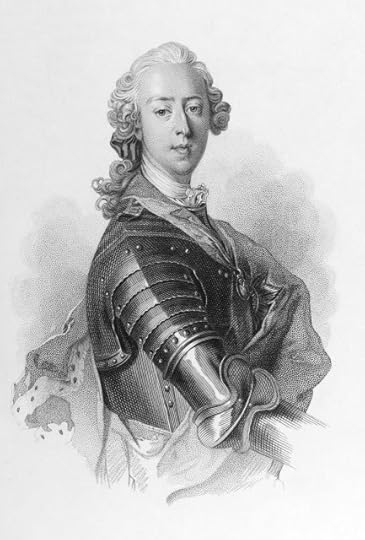 Bonnie Prince Charles.
Bonnie Prince Charles.Not all clans rallied to the Prince’s standard. Some clansmen fought only to avoid any repercussions on their families and homes had they not answered their chief’s call. Other clansmen, like the MacLeods, chose to fight despite their chief’s disapproval.
In the weeks that followed, those Jacobites who fought in and escaped the battle were hunted down and killed. Charles evaded capture for five months. With the help of Flora MacDonald, he eventually made good his escape disguised as a woman and fled to France and final exile.
 Flora MacDonald.
Flora MacDonald.The Jacobites devastating defeat affected the whole future of the Highlands. It fractured and dismantled the Scottish clans and led to the Scottish clearances.
On the two occasions I visited Drumossie Moor, I stood before individual stones which mark the very place where collective clan members fell during the battle. It’s easy to understand why one’s emotions stir when giving thought to hundreds of kilted men whose blood soaked the marshy soil. Their gallant courage has passed into legend.
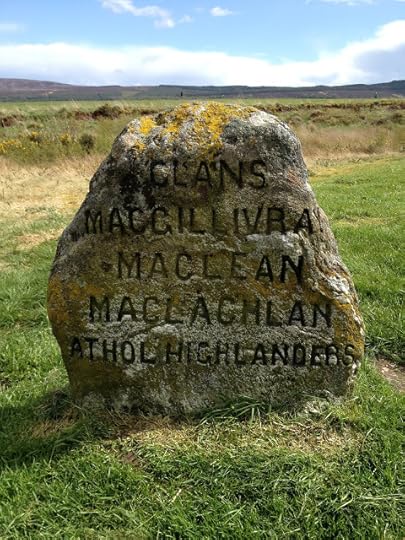
Clan Headstone.
 Chief of MacGillivray.
Chief of MacGillivray.The National Trust for Scotland preserves the battlefield for Culloden, a place of pilgrimage.
 Memorial Cairn.
Memorial Cairn.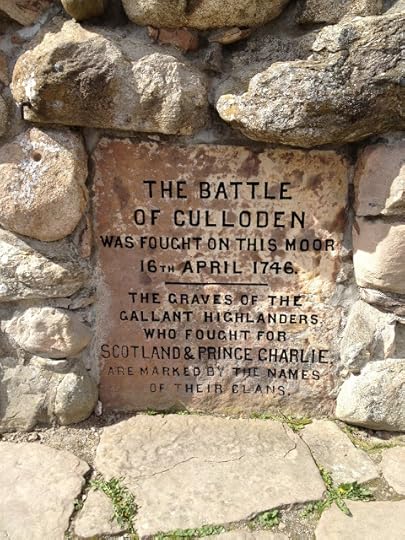 Memorial Plaque/
Memorial Plaque/The Prodigal Laird
 His marriage might cease decades of hostilities between two clans, but that doesn't mean he wants it—or his bold new wife who is keeping secrets of her own.Roderick MacLeod arrives in his native Scottish Highlands to pay brief respects to his recently deceased father—the man Roderick blames for the death of his English mother. But before he can return to England, he is saddled with two responsibilities he never asked for: the title of Laird of Clan MacLeod and an unwanted marriage, by proxy, to the daughter of a rival laird.Annabel MacDonald thought she had the perfect marriage; her husband’s continued absence allowed her independence and the freedom to secretly hide and abet the escape of her fugitive clansmen. When the husband she’d never met shows up, she must convince him to return to England before he uncovers her many secrets, and perhaps her heart.
His marriage might cease decades of hostilities between two clans, but that doesn't mean he wants it—or his bold new wife who is keeping secrets of her own.Roderick MacLeod arrives in his native Scottish Highlands to pay brief respects to his recently deceased father—the man Roderick blames for the death of his English mother. But before he can return to England, he is saddled with two responsibilities he never asked for: the title of Laird of Clan MacLeod and an unwanted marriage, by proxy, to the daughter of a rival laird.Annabel MacDonald thought she had the perfect marriage; her husband’s continued absence allowed her independence and the freedom to secretly hide and abet the escape of her fugitive clansmen. When the husband she’d never met shows up, she must convince him to return to England before he uncovers her many secrets, and perhaps her heart.Pre-Order Links Amazon US • Amazon AU • iBooks• Kobo • Google Play
Vanda Vadas
 Before residing in Australia, Vanda’s birthplace and early childhood years were spent in Papua New Guinea. At the age of eleven, a holiday in England sparked an interest in the days of old. Castles, ruins and discovering Jane Austen novels inspired a lifelong interest in all things historical, a passion that later kickstarted Vanda’s desire to write historical fiction. Her locale and global visits to faraway places inspire her to create fictitious characters and dramas set against authentic and geographical backdrops. Her debut novel, The Pirate Lord, was an Amazon #1 Best Seller in Historical Romance. The Gold Coast is home to Vanda and her husband, where they enjoy walks along world-renowned beaches or a quiet getaway to the lush hills of the Hinterland.
Before residing in Australia, Vanda’s birthplace and early childhood years were spent in Papua New Guinea. At the age of eleven, a holiday in England sparked an interest in the days of old. Castles, ruins and discovering Jane Austen novels inspired a lifelong interest in all things historical, a passion that later kickstarted Vanda’s desire to write historical fiction. Her locale and global visits to faraway places inspire her to create fictitious characters and dramas set against authentic and geographical backdrops. Her debut novel, The Pirate Lord, was an Amazon #1 Best Seller in Historical Romance. The Gold Coast is home to Vanda and her husband, where they enjoy walks along world-renowned beaches or a quiet getaway to the lush hills of the Hinterland.Connect and engage with Vanda via: Website • Facebook• Twitter.
Published on January 29, 2019 23:00
January 28, 2019
Blog Tour — Bittersweet Brooklyn, by Thelma Adams #BittersweetBrooklyn #ThelmaAdams #HFVBTPartner @thelmadams @hfvbt @LUAuthors
Historical Fiction Virtual Blog Tours Presents…

Bittersweet BrooklynBy Thelma Adams
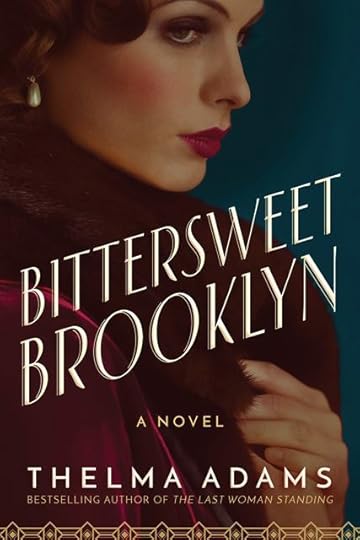
In turn-of-the century New York, a mobster rises—and his favorite sister struggles between loyalty and life itself. How far will she go when he commits murder?
After midnight, Thelma Lorber enters her brother Abie’s hangout under the Williamsburg Bridge, finding Jewish mobster Louis “Pretty” Amberg in a puddle of blood on the kitchen floor. She could flee. Instead, in the dark hours of that October 1935 night before the dawn of Murder, Inc., she remains beside the fierce, funny brother who has nurtured and protected her since childhood. There are many kinds of love a woman can feel for a man, but few compare to that of the baby sister for her older brother. For Thelma, a wild widow tethered to a young son, Abie is the center of her world. But that love is about to undo everything she holds dear…
Flipping the familiar script of The Sopranos, Boardwalk Empire, and The Godfather, Bittersweet Brooklyn explores the shattering impact of mob violence on the women expected to mop up the mess. Winding its way over decades, this haunting family saga plunges readers into a dangerous past—revealed through the perspective of a forgotten yet vibrant woman.
“Thelma Adams has found her niche as a wonderfully vivid historical chronicler of the female spirit. Her tale of a Jewish girl making her way amid gangster-studded NYC is a marvelous must-read.” Michael Musto, columnist
A conversation with Thelma Adams
 I'm Thelma Adams, journalist, critic and novelist. I made my writing reputation reviewing movies in New York – first for the New York Post, then Us Weekly when it went weekly and then covering the Oscars for Yahoo! Movies. Along the way, I interviewed many celebrities including Jessica Chastain, Diane Keaton, Mark Ruffalo, Richard Gere, Kerry Washington, Viggo Mortensen and many more. During that time, while I had two children and shepherded them from Nursery School and into college, I've always written books. I now have three published novels: Playdate, The Last Woman Standing and Bittersweet Brooklyn. I love pizza and fresh peaches, can lecture you about whiskey and write on the left-hand side of a couch I share with five cats (not all at once!).
I'm Thelma Adams, journalist, critic and novelist. I made my writing reputation reviewing movies in New York – first for the New York Post, then Us Weekly when it went weekly and then covering the Oscars for Yahoo! Movies. Along the way, I interviewed many celebrities including Jessica Chastain, Diane Keaton, Mark Ruffalo, Richard Gere, Kerry Washington, Viggo Mortensen and many more. During that time, while I had two children and shepherded them from Nursery School and into college, I've always written books. I now have three published novels: Playdate, The Last Woman Standing and Bittersweet Brooklyn. I love pizza and fresh peaches, can lecture you about whiskey and write on the left-hand side of a couch I share with five cats (not all at once!). It is so nice to meet you, Thelma. Wow! You certainly interviewed some amazing celebrities. Could you tell us what inspired you to write Bittersweet Brooklyn?
So many things inspired me to write Bittersweet Brooklyn, originally entitled Kosher Nostra. The first is being named Thelma after a grandmother who died before I was born – she left so little behind except what passed through my father. And, then, that name: Thelma! Try playing kickball with that on the Southern California playground. Worst nickname: Thudma. Who was this woman? I knew I wouldn't find out anything about her in the newspapers or much in census records – but she had this brother, Abie, who became a low-level thug in the Jewish mob aka Murder Inc. That was a way in: what happened when you flipped the mobster saga and focused on the women in the family? I wanted to know. And I never could have predicted what I found out about them and their house on Montauk Avenue in East New York, Brooklyn.
Did you face many research challenges?
The major challenge – and surprise – was that I thought I would be able to access Abie's criminal records in New York. But the records, on micro fiche, and often in an ornate cursive, and disbursed through a number of archives, were hard for me to sort through (especially with imperfect eyesight). I sometimes wonder if his criminal history was scrubbed. But that left me with newspapers, which are growing more accessible everyday thanks to the internet, and the wonders of Ancestry.com. Through Ancestry, and requests for death, birth and marriage records, I began to piece together the lives this family lived together. And I traced their rise from relying on Hebrew charity to owning a house in the new neighbourhood of East New York. I have to give a shout-out to Nick Hitchcock, the historian son of an historian friend from college, for doing the shoe-leather research that allowed me to discover when the family bought the house on Montauk Avenue that provided them with a new level of stability – and the surprising names on the deed.
It sounds like you spent many hours researching. Can you tell us what makes your book different to other turn-of-the- century novels out there?
There are many books about turn-of-the-century New York and the immigrant experience – whether it's E. L. Doctorow's Billy Bathgate that was made into a movie with Dustin Hoffman, or Alfred Kazin's contemporaneous account A Walker in the City. However, there aren't as many novels that focus on a female heroine and her narrative arc, her struggle under the historical radar. That's one thing that sets this novel apart. Also, novels with criminal elements tend to focus on the bang-bang of it all but I have chosen to see how a life of crime – and the freedom it can create from suffocating norms – impacts the entire family. And, into this, I put a woman who wants to live, to have an ecstatic experience with life itself, to dance and experience joy -- but she's not a perfect individual or a responsible mother, which is not a common main character in the literature of that time period. She was a liberated woman well before her time – and paid a price for it.
Can you tell us what you are currently working on?
I'm currently working on a very different historical novel called May the Circle Be Unbroken also largely set in New York. It’s about the entangling of Spiritualists and Suffragists in the fight for woman’s rights in mid-19th Century America from the viewpoint of a Spiritual Medium. It includes many historical characters including Horace Greeley, Susan B. Anthony and Elizabeth Cady Stanton.
Thank you so much for taking time out of your busy day to chat to us!
Scroll down for a fabulous Giveaway.
Giveaway
During the Blog Tour we will be giving away two paperback copies and one Audio Book! Enter the Giveaway HERE!
Giveaway Rules
• Giveaway ends at 11:59pm EST on February 15th. You must be 18 or older to enter.• Giveaway is open to US only.• Only one entry per household.• All giveaway entrants agree to be honest and not cheat the systems; any suspect of fraud is decided upon by blog/site owner and the sponsor, and entrants may be disqualified at our discretion.• Winner has 48 hours to claim prize or new winner is chosen.
AMAZON | BARNES AND NOBLE
Thelma Adams
 Thelma Adams is the author of the best-selling historical novel, The Last Woman Standing and Playdate, which Oprah magazine described as "a witty debut novel." In addition to her fiction work, Adams is a prominent American film critic and an outspoken voice in the Hollywood community. She has been the in-house film critic for Us Weekly and The New York Post, and has written essays, celebrity profiles and reviews for Yahoo! Movies, The New York Times, O: The Oprah Magazine, Variety, The Hollywood Reporter, Parade, Marie Claire and The Huffington Post. Adams studied history at the University of California, Berkeley, where she was valedictorian, and received her MFA from Columbia University. She lives in upstate New York with her family.
Thelma Adams is the author of the best-selling historical novel, The Last Woman Standing and Playdate, which Oprah magazine described as "a witty debut novel." In addition to her fiction work, Adams is a prominent American film critic and an outspoken voice in the Hollywood community. She has been the in-house film critic for Us Weekly and The New York Post, and has written essays, celebrity profiles and reviews for Yahoo! Movies, The New York Times, O: The Oprah Magazine, Variety, The Hollywood Reporter, Parade, Marie Claire and The Huffington Post. Adams studied history at the University of California, Berkeley, where she was valedictorian, and received her MFA from Columbia University. She lives in upstate New York with her family.
Published on January 28, 2019 23:30
Kings, Gods and Battles: Re-imagining a legend of the Viking Age, by Theodore Brun #History #Vikings @theodorebrun
Kings, Gods and Battles: Re-imagining a legend of the Viking Age.
By Theodore Brun
My first novel, A Mighty Dawnwas set in the domain of Old Norse myth. The second book in the series, A Sacred Storm, progresses the story into the realm of legend.
Is there a difference? Well, I think so.
When I first began weaving together the plot running through the two books, the climax of the second was to centre on a fictitious blood feud between two rival kingdoms that escalates into a battle of epic proportions. But then, during the course of my research, I came across a handful of historical sources that describe just such a battle having taken place. Something evoking the Old Norse answer to the Iliad, or so it seemed to me, in which gods and heroes both stalk the battlefield.

Study of the Battle of Bråvalla by August Malmström – Nationalmuseum Stockholm
The accounts describe a large battle that occurred in what is now Sweden at some point in the middle of the 8thcentury, now known as the Battle of Brávellir (sometimes Bråvalla). This made my job considerably easier, providing, as it did, a wonderful level of detail.
The central character connected with the battle is a man called Harald Wartooth who, as soon as I struck upon him, I felt was pure box office. King of the Danes, Haraldr Hilditǫnn - known as the Wartooth - was almost certainly a real person. So named either because he lost a couple of teeth in a battle which then miraculously grew back, or else because of the odd setting of his front teeth.
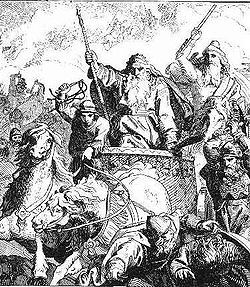 Harald Wartooth at the Battle of Brávellir. Illustration by the Danish artist Lorenz Frølich.
Harald Wartooth at the Battle of Brávellir. Illustration by the Danish artist Lorenz Frølich.He is one of the most striking characters in all the Old Norse sagas and is identified in several sources as ruler over a territory that stretched from Eastern Scandinavia (modern-day Finland and Estonia) as far west as Northumberland in northern England. Most of the detail on him that I use in A Sacred Storm comes from one surviving fragment of a saga, known as the Sögubrot.
However, the many stories and escapades spanning Harald’s life were eventually compiled as one part of a much larger work called the Gesta Danorum - the Deeds of the Danes - by a 12th century Danish historian called Saxo Grammaticus. (Incidentally, this book is where Shakespeare found the original story about a Jute prince called Amleth. Better known as Hamlet.)
 Illustration of Saxo Grammaticus, author of the Gesta Danorum - the first full history of the Danes; by Louis Moe.
Illustration of Saxo Grammaticus, author of the Gesta Danorum - the first full history of the Danes; by Louis Moe.The episodes about Harald in the Gesta Danorum are many and colourful. Even from his birth, the Wartooth was special, his mother only conceiving him after a visit to an oracle of Odin and dedicating the life of any resulting child in service to that god.
Thus favoured by the war-god Odin, Harald Wartooth never wore armour in combat – suggesting that he was also a “berserker”. Even so, according to Saxo, Harald survived as king over Denmark and several other vassal kingdoms until the ripe old age of 127 (which stretches the bounds of credulity, to say the least). With the infirmities of age, he became increasingly paranoid that his more ambitious and unscrupulous underlings were trying to bump him off. His fears were not without foundation; there were several attempts to murder him, one of them in his bath. The Wartooth’s resulting determination notto die such an ignominious death, but instead to see out his days with one last, glorious battle, becomes the main driver for “arranging” a battle with a younger kinsman called Sigurd Hring, the king of Sweden (or Sveäland, as I call it).
The Battle of Brávellir became the stuff of legend. This epic clash of arms is described in both the sources mentioned, as well as The Saga of Hervör and Heidrek, and The Saga of Bósi and Herraud.
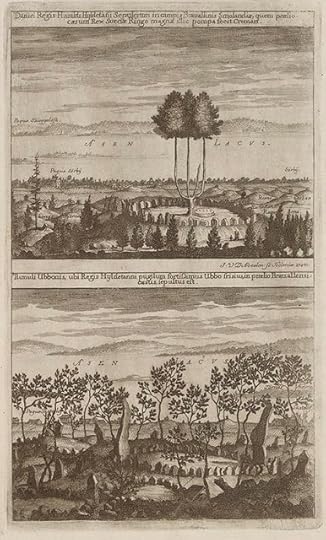 17th century engraving by Erik Dalhbergh of the Grave Mounds of Harald Wartooth (above) and Ubbi the Frisian (below) by Lake Åsnen in Sweden – both men fell at the Battle of Brávellir
17th century engraving by Erik Dalhbergh of the Grave Mounds of Harald Wartooth (above) and Ubbi the Frisian (below) by Lake Åsnen in Sweden – both men fell at the Battle of BrávellirThe way Saxo describes it, the battle came about rather in the manner of one king organising a football match against the other. A time and place were arranged. It was agreed that each side should have seven years to assemble the largest host they possibly could. One account puts more weight on the fact that the Wartooth spent those seven years harrying the borderlands with provocations that the Swedish king couldn’t ignore. This rings a little truer than the notion of a kind of glorified prizefight convened as a handy means of despatching this long-lived Danish king into the afterlife.
Be that as it may, the battle involved all the greatest champions of the age, and my account of the multitude of different tribes and people-groups, from lands as diverse as Russia to Ireland, is no exaggeration. Several of the champions mentioned in the sources appear in my novel: Starkad the Old, Ubbi the Frisian, Einar the Fat-Bellied, Grim and Geir of Hedmark, the shieldmaiden Visma to name just a few. Perhaps most notable is the Wartooth’s own banner-bearer, named Bruni. He was said to be the man who struck the death-blow to the old and blind King Harald, at last giving him the glorious death-in-combat that he was seeking, thereby setting him on his road to Valhalla and, incidentally, bringing the battle to a close. Bruni himself was never seen again. Thus a legend grew that Harald’s banner-bearer had in fact been the god Odin in disguise – the Wanderer stalking through the maelstrom of heroes in “Skogul’s Storm”.
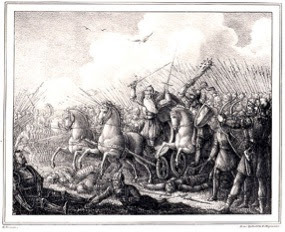 Etching by Hugo Hamilton (1830), depicting Harald Wartooth falling in the Battle of Bråvalla
Etching by Hugo Hamilton (1830), depicting Harald Wartooth falling in the Battle of BråvallaWith the cast-iron truth about the lives and deaths of these ancient kings and warriors now lost in the mists of time, all of this hovers somewhere over the line between legend and history. But I hope that, whatever licenses I have afforded myself with the accepted facts in the writing of A Sacred Storm, readers will enjoy the story for what it is – an epic tale come down to us from the dawn of the Viking Age.
A Sacred Storm
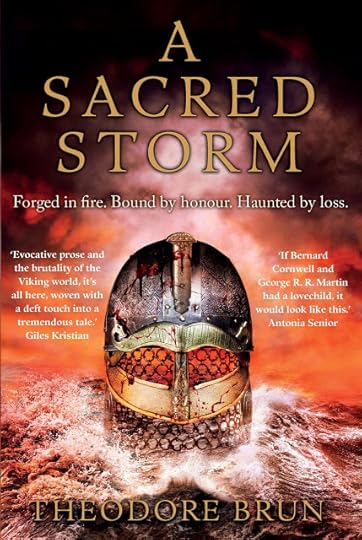
Forged in fire. Bound by honour. Haunted by loss.
8th Century Sweden: Erlan Aurvandil, a Viking outlander, has pledged his sword to Sviggar Ivarsson, King of the Sveärs, and sworn enemy of the Danish king Harald Wartooth. But Wartooth, hungry for power, is stirring violence in the borderlands. As the fires of this ancient feud are reignited Erlan is bound by honour and oath to stand with King Sviggar.
But, unbeknownst to the old King his daughter, Princess Lilla, has fallen under Erlan's spell. As the armies gather Erlan and Lilla must choose between their duty to Sviggar and their love for each other.
Blooded young, betrayed often, Erlan is no stranger to battle. And hidden in the shadows, there are always those determined to bring about the maelstrom of war...
“Evocative prose and the brutality of the Viking world, it's all here, woven with a deft touch into a tremendous tale.” Giles Kristian on A Mighty Dawn
“Brun writes with passion and his recreation of this bloody, fascinating world is convincing.” The Times
“A rip-roaring blockbuster brought to life in vivid detail. You can smell the smoke of the Viking hall, taste the burning desire for revenge.” Justin Hill
“Blood-pumping Viking action that hurls the reader into the maelstrom of a medieval battlefield. Historical storytelling of the very highest calibre.” Angus Donald
“At the point where history and myth blurs, Brun has crafted a thunderous epic of blood and fire, love and loss that will keep you reading deep into the night.”James Wilde
Available on Amazon Kindle NOW!
Amazon
A Sacred Storm is out in paperback on February 07, 2019
Pre-order the paperback TODAY!
Amazon
Hardback Available from:
Waterstones
Theodore Brun
 Theodore Brun studied Dark Age archaeology at Cambridge, where he graduated with a BA in Archaeology and Anthropology and an MPhil in History. Professionally, Theodore worked as an arbitration lawyer, in London, Moscow, Paris and finally Hong Kong. In 2010, he quit his job in Hong Kong and cycled 10,000 miles across Asia and Europe to his home in Norfolk. Theodore is a third generation Viking immigrant, his Danish grandfather having settled in England in 1932. He is married and lives in London.
Theodore Brun studied Dark Age archaeology at Cambridge, where he graduated with a BA in Archaeology and Anthropology and an MPhil in History. Professionally, Theodore worked as an arbitration lawyer, in London, Moscow, Paris and finally Hong Kong. In 2010, he quit his job in Hong Kong and cycled 10,000 miles across Asia and Europe to his home in Norfolk. Theodore is a third generation Viking immigrant, his Danish grandfather having settled in England in 1932. He is married and lives in London.
Published on January 28, 2019 23:00
January 27, 2019
Love and Hate with the Earl of Strafford, by Nancy Blanton #History #Stuarts #HistoricalFiction @nancy_blanton
Can you love a person and despise him at the same time? Can you admire someone for his sense of honor and his intellect, and abhor his dispassionate cruelty and greed?
Such was the conflict encountered while researching and writing about the infamous Earl of Strafford, Thomas Wentworth, for my latest novel, The Earl in Black Armor. Here was a man who stirred people’s passions to one extreme or the other. In his brightest hour, as chief advisor to King Charles Iof England, he was loved by some and deeply hated by others. And yet, one is likely to feel respect for him, if not true admiration.
In my story, protagonist Faolán Burke spies on Wentworth at Dublin Castle, where he meets the alluring Denisa Dumalin. Denisa, a personal assistant to Wentworth, spies on the man also, but for very private reasons. Faolán is soon likewise torn—by his allegiance to his clan, his love for Denisa, concern for his daughter’s future, and his sense of honor and admiration for Wentworth.
 Dublin Castle and Chapel, about 1903, The Newberry collection,
Dublin Castle and Chapel, about 1903, The Newberry collection,Born on April 13, 1593 to a wealthy, respected family in York, Thomas Wentworth became a man of ambition, responsibility and high standards, generally acknowledged by his peers as a wise and effective administrator. He became a member of the English Parliament at just 21 years of age. He soon exhibited his ideals and determination, willing to go to prison with many of his peers rather than pay to the king what he considered a forced loan. In 1628, Wentworth was one of the authors of The Petition of Right, a constitutional document to define and protect the people’s liberties against such things as forced loans and forced billeting of soldiers in people’s homes.
He made perhaps his first and worst enemies when he accepted a position at court offered by King Charles. To his fellow parliamentarians, it appeared he was betraying them and selling out to the king. But Wentworth aspired to a court position, believing in the divine right of kings. He believed he’d have greater influence to advance reforms if he worked within the king’s court, rather than outside of it.
Wentworth demonstrated his capabilities so well, that soon colleagues urged him to accept the position of Lord Deputy of Ireland, to replace Lord Falkland, whom the king had recalled. Those colleagues may have had darker motives, wanting to remove Wentworth from consideration for the more lucrative position as the king’s treasurer in London. And, there is some suggestion that King Charles admired Wentworth’s abilities but also saw him as a threat. Wentworth accepted the Ireland post in 1632, eager to please the king by filling the treasury, and perhaps to earn a coveted earldom.
Arriving in Ireland in 1633, he established himself quickly as a man of fairness and action, by stopping the piracy that strangled trade, restoring law and order, and—by his policy of “thorough”—rooting out the corruption that lined the pockets of the wealthy at the expense of the poor. This policy made him rather unpopular with powerful nobles who had used their positions for personal gain.
The same and other nobles also feared Wentworth’s plans to expand the English plantation system in Ireland, displacing Irish clans, destroying traditions, and eliminating the Irish way of life—including the Catholic religion that remained strong in the western counties.
Wentworth’s demeanor did not help, for he was intimidating, quick to anger, and his occasional cruelty caused many to hate him.
Haven’t we all experienced, or at least known of,such a person? A few modern examples come to mind. The beloved storyteller Walt Disney, for example, became the king of animation. He was greatly admired for his creativity and vision, and yet he was known to be an obsessive perfectionist and tyrant. The same might be said of Steve Jobs, a king of the microcomputer revolution, who was brilliant but also ruthlessness and cruel on a personal level. Anna Wintour, on whom the movie The Devil Wears Prada was likely based, became queen of the fashion industry, and yet was feared by her staff, made impossible demands, and gained a reputation of being rude to almost everyone.
In their defense, however, they managed under enormous pressures to help build major industries that employed millions of people—people who stayed with them because of their vision and power to succeed.
Wentworth succeeded on several levels to improve conditions in Ireland while earning the king’s favor. He made dozens of enemies along the way including the Earl of Cork, who was featured in my previous book, The Prince of Glencurragh. In time, Wentworth received his earldom, and much more. But King Charles was not the stalwart figure one hopes for in a monarch. Though Wentworth was the king’s chief advisor during the Bishops Wars, his advice often was not taken, and some of his recommendations may have been misconstrued. Did he, or did he not, suggest the king should use the Irish Army against his own people?
Faolán’s objective as a spy is fulfilled when the wars end at Newburn in 1640, but now he faces fierce inner conflicts and realizations about his own past that threaten to destroy him, just as the Earl of Strafford faces a bitter fight for his life.
As the author, I felt equally plagued by inner conflicts, influenced by historical writers on whose research I depended. I used several sources to study Wentworth and the events from 1633 to 1641, including C.V. Wedgwood, Elizabeth Cooper, Hugh Kearney, and more. Wedgwood and Cooper in particular exhibited mixed feelings about Wentworth. Wedgwood first wrote Wentworth’s biography when she was 25, then depicting him as a brave and able man. However, when new sources became available 30 years later, she revised it to produce “A Revaluation,” recognizing Wentworth’s greediness and tendency to apply laws to others but not to himself.
But Wentworth was not alone in this, and was probably not the worst of them in a time when corruption and the king’s favor were the best, if not the only paths to advancement. Wentworth is remembered as a tyrant and a statesman, but his contemporaries in Parliament have much worse to answer for.
The Earl in Black Armor

LOYALTY, BETRAYAL, HONOR AND TYRANNY IN THE REIGN OF KING CHARLES I, 1635
When the clan leader sends Faolán Burke to Dublin to spy on Thomas Wentworth, the ruthless Lord Deputy of Ireland, the future of his centuries-old clan rests upon his shoulders. Wentworth is plotting to acquire clan lands of Connacht for an English Protestant plantation. To stop him, Faolán must discover misdeeds that could force King Charles to recall Wentworth to England. Leaving his young daughter Elvy in the care of his best friend Aengus, Faolán works as a porter in Dublin Castle, and aligns with the alluring Denisa, Wentworth’s personal assistant. She, too, spies on Wentworth, but for very personal reasons. While Faolán knows he should hate Wentworth, he admires his prosecution of pirates and corrupt nobles who prey on Irish merchants. Supremely arrogant and cruel to his enemies, Wentworth shows loyalty, warmth and compassion for family, friends and a few select others.A common mission takes Faolán and Denisa from Dublin to London and Hampton Court; to York and Scotland; and to the highest levels of court intrigue and power. But secrets, fears, war and betrayal threaten their love—and even their lives. And as Wentworth’s power grows, so grow the deadly plans of his most treacherous and driven enemies.
Amazon UK • Amazon US
Nancy Blanton
 Nancy Blanton writes award-winning novels based in 17thcentury Irish history.
The Prince of Glencurragh
, her second novel, occurs in 1634 during the English Plantation of Ireland. Her first novel,
Sharavogue
, is set in Ireland and the West Indies during the time of Oliver Cromwell. In non-fiction,
Brand Yourself Royally in 8 Simple Steps
is also a medalist, providing a valuable personal branding guide for authors, artists, and business consultants. Ms. Blanton is a member of the Historical Novel Society. She has worked as a journalist, magazine editor, corporate communications leader and brand manager. Her books celebrate her love of history and her Irish/English heritage. She lives in Florida.
Nancy Blanton writes award-winning novels based in 17thcentury Irish history.
The Prince of Glencurragh
, her second novel, occurs in 1634 during the English Plantation of Ireland. Her first novel,
Sharavogue
, is set in Ireland and the West Indies during the time of Oliver Cromwell. In non-fiction,
Brand Yourself Royally in 8 Simple Steps
is also a medalist, providing a valuable personal branding guide for authors, artists, and business consultants. Ms. Blanton is a member of the Historical Novel Society. She has worked as a journalist, magazine editor, corporate communications leader and brand manager. Her books celebrate her love of history and her Irish/English heritage. She lives in Florida.References:
Cover Design: portrait of Thomas Wentworth, 1stEarl of Strafford, about 1633, painting after Sir Anthony van Dyck. National Portrait Gallery 2960.
Thomas Wentworth, 1st Earl of Strafford, with Sir Philip Mainwaring, between 1639 and 1640, painting by Sir Anthony van Dyck. Public Domain.
Dublin Castle and Chapel, about 1903, The Newberry collection, public domain.
Published on January 27, 2019 23:00
January 25, 2019
#BookReview — The Briton and the Dane: Concordia (The Briton and the Dane #4) By Mary Ann Bernal #HistoricalFiction #HistoricalRomance @BritonandDane
The Briton and the Dane: Concordia(The Briton and the Dane #4)By Mary Ann Bernal
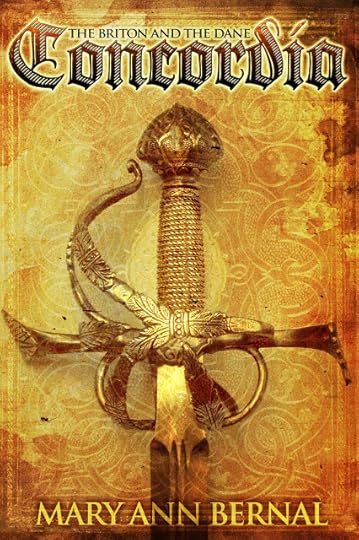
Travel back in time to late Ninth Century Anglo-Saxon Britain where Alfred the Great rules with a benevolent hand while the Danish King rules peacefully within the boundaries of the Danelaw. Trade flourishes, and scholars from throughout the civilized world flock to Britannia’s shores to study at the King’s Court School at Winchester.
Enter Concordia, a beautiful noble woman whose family is favored by the king. Vain, willful, and admired, but ambitious and cunning, Concordia is not willing to accept her fate. She is betrothed to the valiant warrior, Brantson, but sees herself as far too young to lay in the bedchamber of an older suitor. She wants to see the wonders of the world, embracing everything in it; preferably, but dangerously, at the side of Thayer, the exotic Saracen who charms King Alfred’s court and ignites her yearning passions.
Concordia manipulates her besotted husband into taking her to Rome, but her ship is captured by bloodthirsty pirates, and the seafarers protecting her are ruthlessly slain to a man. As she awaits her fate in the Moorish captain’s bed, by sheer chance, she discovers that salvation is at hand in the gilded court of a Saracen nobleman.
While awaiting rescue, Concordia finds herself at the center of intrigue, plots, blackmail, betrayal and the vain desires of two egotistical brothers, each willing to die for her favor. Using only feminine cunning, Concordia must defend her honor while plotting her escape as she awaits deliverance, somewhere inside steamy, unconquered Muslim Hispania.

Someone should have told Concordia that when wishes come true they can leave a very bitter taste.
It had been very easy to fall in love with the young and handsome man from Hispania, but alas, their romance was never meant to be. It was nothing but an inexperienced girl’s foolish dream.
Several years have passed, and Concordia has not seen or heard anything more of Thayer, but not for one moment has she stopped loving him. Since that night, Concordia has worn the necklace Thayer gave her. He was still the first thing she thought about in the morning and the last thing at night. She wished ardently to speak with him, to see him, just one more time.
Concordia marries a man whom she regards as a very dear friend. She should be content. Nevertheless, her heart still belongs to Thayer. Desperate to please his young wife, Brantson takes her on a voyage — their destination, Rome. However, they never make it, for their boat is boarded by Saracen pirates. What was to be an adventure of a lifetime, soon turns into a harrowing nightmare.
If Concordia is to survive, then she must use her wits and her body, but there is no telling if even that will be enough. If only Thayer were here to save her. He would assure her safety and if nothing else, return her to her homeland.
From the comfort of King Alfred’s Great Hall to the terror of captivity in a foreign land, The Briton and the Dane: Concordia (The Briton and the Dane #4) by Mary Ann Bernal is the unforgettable story of one woman’s quest to find true love and in doing so find herself as well.
Set firmly in the 9th Century, The Briton and the Dane: Concordia, drew me in from the opening sentence and held me enchanted until the very end. Bernal’s narrative was not only utterly irresistible but incredibly vivid in the telling. This is a story that threatened to mesmerise. It was so compelling that I read it in one sitting. There was no way I could put this book down once I had started.
Concordia is an unlikely heroine. She is spoilt and conceited. However, there is an endearing innocence about her, and for anyone whose first love was unrequited, there is a recognition of her daydreams and her heartache. She pines terribly for Thayer. As a character, Concordia certainly does her fair share of growing up as the novel progresses. Her relationship with Chad, the Saracen pirate, gave this story an unexpected twist. Of all the men in Concordia’s life, Chad, although not the most honest, is more than a match for our fiery young heroine’s free spirit.
The antagonist of this tale is an unlikely one. Thayer speaks with a double-tongue. He is not what he seems and Concordia learns a harsh but terrible lesson which is to not take anyone at face-value. Her love for him is pure, but his love for her is about control and dominance. He is the serpent who promises much but delivers nothing but heartache.
Bernal paints a dazzling portrait of what life was like in 9th Century Hispania. There is an elegant sweep of historical brilliance, giving this book an almost sensual grounding of time and place. Bernal has certainly woven the history into this incredibly enthralling tale. I was particularly interested in Bernal’s depiction of the Emirate of Cordova (Emirate of Córdoba). This was a time of power struggles and dynasties, but it was also the beginning of a political decline of the emirate. I think Bernal has captured the essence of this era very well through her fictional portrayal. The tension between the Muslim community and the Christian one is evident throughout this story, and indeed history tells us that there was much unrest, particularly at the Christian border.
Although this is book #4 in the series, Concordia stands very firmly on her own two feet. So, if you are looking for your next fix of historical fiction, then why not check out The Briton and the Dane: Concordia (The Briton and the Dane #4) by Mary Ann Bernal.
I Highly Recommend.
Mary Anne Yarde.The Coffee Pot Book Club.
Amazon UK • Amazon US
Mary Ann Bernal
 Mary Ann Bernal attended Mercy College, Dobbs Ferry, NY, where she received a degree in Business Administration. Her literary aspirations were ultimately realized when the first book of The Briton and the Dane novels was published in 2009. In addition to writing historical fiction, Mary Ann has also authored a collection of contemporary short stories in the Scribbler Tales series. Her latest endeavor is a science fiction/fantasy novel entitled Planetary Wars Rise of an Empire. Originally hailing from New York, Mary Ann now resides in Elkhorn, Nebraska.
Mary Ann Bernal attended Mercy College, Dobbs Ferry, NY, where she received a degree in Business Administration. Her literary aspirations were ultimately realized when the first book of The Briton and the Dane novels was published in 2009. In addition to writing historical fiction, Mary Ann has also authored a collection of contemporary short stories in the Scribbler Tales series. Her latest endeavor is a science fiction/fantasy novel entitled Planetary Wars Rise of an Empire. Originally hailing from New York, Mary Ann now resides in Elkhorn, Nebraska.Connect with Mary Ann: Website • Whispering Legends Press • Twitter.
Published on January 25, 2019 23:30
The Coffee Pot Book Club
The Coffee Pot Book Club (formally Myths, Legends, Books, and Coffee Pots) was founded in 2015. Our goal was to create a platform that would help Historical Fiction, Historical Romance and Historical
The Coffee Pot Book Club (formally Myths, Legends, Books, and Coffee Pots) was founded in 2015. Our goal was to create a platform that would help Historical Fiction, Historical Romance and Historical Fantasy authors promote their books and find that sometimes elusive audience. The Coffee Pot Book Club soon became the place for readers to meet new authors (both traditionally published and independently) and discover their fabulous books.
...more
...more
- Mary Anne Yarde's profile
- 159 followers



